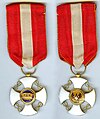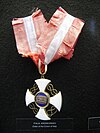Order of the Crown of Italy
This article needs additional citations for verification. (December 2017) |
| Order of the Crown of Italy Ordine della Corona d'Italia | |
|---|---|
 Star of the Grand Cordon set of the Order | |
| Awarded by The Head of the Italian Royal Family | |
| Type | Dynastic Order of Knighthood |
| Established | 20 February 1868 |
| Royal house | House of Savoy |
| Eligibility | Military, civilian |
| Awarded for | Meritorious Service or Achievement |
| Status | Rarely constituted |
| Founder | King Victor Emmanuel II |
| Grand Master | Prince Vittorio Emanuele, Prince of Naples |
| Chairman of the Council | Prince Emanuele Filiberto, Prince of Venice |
| Grades | Grand Cordon, Special Class Grand Cordon Grand Officer Commander Officer Knight/Dame |
| Precedence | |
| Next (higher) | Royal Order of Saints Maurice and Lazarus |
| Next (lower) | Royal Civil Order of Savoy Royal Military Order of Savoy |
Ribbon bar | |
The Order of the Crown of Italy, Italian: Ordine della Corona d'Italia, was founded as a national order in 1868 by King Vittorio Emanuele II, to commemorate the unification of Italy in 1861.[1] It was awarded in five degrees for civilian and military merit.
Compared with the older Order of Saints Maurice and Lazarus (1572), the Order of the Crown of Italy was awarded more liberally and could be conferred on non-Catholics as well; eventually, it became a requirement for a person to have already received the Order of the Crown of Italy in at least the same degree before receiving the Order of Saints Maurice and Lazarus.
The order has been suppressed by law since the foundation of the Republic in 1946. However, Umberto II did not abdicate his position as fons honorum and it remained under his Grand Mastership as a dynastic order. While the continued use of those decorations conferred prior to 1951 is permitted in Italy, the crowns on the ribbons issued before 1946 must be substituted for as many five pointed stars on military uniforms.[2]
Grades
The various degrees of the order, with corresponding ribbons, were as follows:
Insignia
 | ||||
| Medaglie | ||||
|---|---|---|---|---|
 |
 |
 |
 |
 |
| Regno d'Italia | ||||
| Repubblica Italiana e Casa Savoia | ||||
- The badge of the order was a gilt cross with curved edges, enamelled in white, with the so-called Savoy knots between the arms of the cross. The obverse central disc featured the Iron Crown of Lombardy (as appeared on the Austrian Order of the Iron Crown) on a blue enamel background. The reverse central disc had a black-enamelled eagle bearing the Savoy cross on a golden background.
- The star of the Grand Cross was an eight-pointed faceted silver star; the central disc featured the Iron Crown on a blue enamelled background, surrounded by a white enamel ring bearing the inscription VICT. EMMAN. II REX ITALIAE MDCCCLXVI (Victor Emmanuel II, King of Italy, 1866). There was a black-enamelled eagle bearing the Savoy cross above the star.
- The star of the Grand Officer was an eight-pointed faceted silver star with ball tips at each point and with the obverse of the badge superimposed upon it.
- The ribbon of the order was red-white-red.
Members
Members of the order have included:
- John Buchan (1875–1940), Scottish novelist and diplomat
- Vice Admiral Felice Napoleone Canevaro (1838–1926), Italian admiral and diplomat
- Arthur Conan Doyle (1859–1930), Scottish statesman and Sherlock Holmes author
- James Whitelaw Hamilton (1860–1932), Scottsh artist, member of the Royal Scottish Academy
- Thomas Hanbury (1832–1907), English philanthropist and creator of the Giardini Botanici Hanbury
- Vice Admiral Jules James (1885-1957) Commander, U.S. Naval Forces, Mediterranean at the close of WW II, decorated by the last King of Italy, Umberto II during his 34 day reign.
- Major General Clayton P. Kerr (1900–1977), United States Army general, World War II member of the Allied Mission to the Italian Army
- Major General Robert A. McClure (1897–1957), father of U.S. Army Special Operations, Director of Information and Media Control at Supreme Headquarters Allied Expeditionary Force (SHAEF) during World War II
- Brigadier General Billy Mitchell (1879–1936), United States Army air power advocate
- Charles Poletti (1903–2002), American lawyer and politician, Governor of New York, and colonel in the United States Army; served in Italy during World War II
- John Rylands (1801–1888), English entrepreneur and philanthropist
- Rear Admiral Yates Stirling, Jr. (1872–1948), United States Navy sea power advocate
- Harry Woodburn Blaylock (1878–1928), Canadian lawyer and businessman[3]
See also
References
- ^ Founded by Royal Decree No. 4251 of 20 February 1868, renewed by Royal Decree No. 4850 of 24 January 1869, Royal Magistral Decree of 17 November 1907 and Royal Decree No. 276 of 16 March 1911
- ^ Ordini Cavallereschi del Regno d'Italia Archived 2010-01-20 at WebCite Corpo della Nobiltà Italiana (retrieved 10 September 2009)
- ^ Tremblay, Yves (2005). "BAYLOCK, HARRY WOODBURN". Dictionary of Canadian Biography. Vol. Vol. 15. University of Toronto/Université Laval. Retrieved 28 September 2018.
{{cite encyclopedia}}:|volume=has extra text (help)










